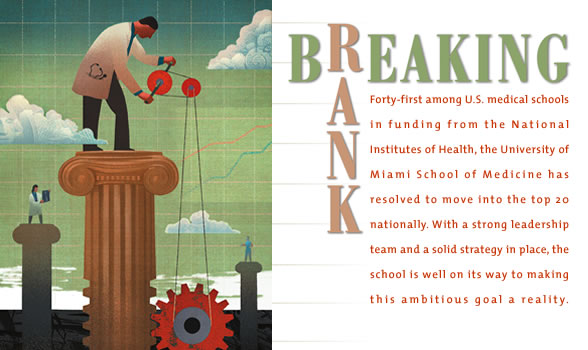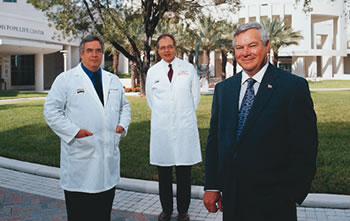
 r.
Clyde McCoy calls the research money available from the National Institutes
of Health “a big pot of gold at the end of the rainbow.” He’s
doing everything he can to make sure the University of Miami School of
Medicine’s share grows astronomically in the next few years.
r.
Clyde McCoy calls the research money available from the National Institutes
of Health “a big pot of gold at the end of the rainbow.” He’s
doing everything he can to make sure the University of Miami School of
Medicine’s share grows astronomically in the next few years.
The ultimate goal? To move the medical
school into the top 20 in the nation in NIH funding, what Dean John G.
Clarkson, M.D. ’68, calls the “gold standard,” within ten
years.
McCoy, Ph.D., chairman of the Department
of Epidemiology and Public Health and director of the Comprehensive Drug
Research Center, can’t resist drawing a parallel to the University’s
phenomenally successful athletic program: “We are in the top 20 in
baseball and football and now basketball,” he told UM President’s
Council members during their spring visit to the medical campus. “I
don’t want to think of ourselves as anywhere but the highest echelon
in medical research.”
![]() s
it doable? McCoy and his two colleagues who are at the helm of the Executive
Office of Research Leadership are confident the University can climb that
far from No. 41. “It’s going to be tough,” says codirector
James D. Potter, Ph.D., chairman of the Department of Molecular and Cellular
Pharmacology. “We’re going to have to do some phenomenal things.
It will require steady growth of quality faculty, quality students, quality
facilities.”
s
it doable? McCoy and his two colleagues who are at the helm of the Executive
Office of Research Leadership are confident the University can climb that
far from No. 41. “It’s going to be tough,” says codirector
James D. Potter, Ph.D., chairman of the Department of Molecular and Cellular
Pharmacology. “We’re going to have to do some phenomenal things.
It will require steady growth of quality faculty, quality students, quality
facilities.”
Or, in the words of McCoy’s ever-present sports metaphors: “This would be akin to moving from unranked to winning the national championship, which both the football and baseball programs at UM have accomplished not once but multiple times. We have the opportunity to accomplish an even more spectacular miracle in Miami, one of much greater importance for our place historically and for our contribution to the future health of societies.”
It is not by accident that three of the University’s most active researchers were put in charge of this monumental initiative. Since joining the University 28 years ago, McCoy has become internationally known for his community and population studies in cancer, substance abuse, health services, and HIV/AIDS. He is joined by codirectors Potter, who is renowned for his research on the regulation of muscle contraction and is developing animal models for cardiovascular disease, and Camillo Ricordi, M.D., scientific director of UM’s Diabetes Research Institute (DRI) and a world leader in the field of islet cell transplantation.
 |
||
Ricordi prefers to talk about creating an infrastructure for greatness rather than about where the University ranks in NIH funding. “Our foremost goal should be to foster the process of discovery to develop new therapeutic strategies that help patients,” he says. “The big opportunity is to learn from very successful initiatives within UM that are already in the top ten or top three in the country and extend similar strategies and opportunities to the entire school.”
One of those very successful initiatives is the DRI, which ranks first in the country for research funding in Type I diabetes. “I didn’t target how to get to be No. 1 in funding,” Ricordi says. “Our objective has been how to develop and apply new treatments for patients in the fastest, most efficient, and safest way possible. We allowed investigators to capitalize on our leadership position, shared equipment, and level of excellence to develop additional successful programs. If you are excellent in your job and have an outstanding team, it will be reflected in your NIH ranking.”
Among other model UM programs Ricordi mentions are the Sylvester Comprehensive Cancer Center, the organ transplant program, The Miami Project to Cure Paralysis, the Bascom Palmer Eye Institute, and the emerging area of stem cells, cellular therapies, and tissue engineering. “These examples have grown through entrepreneurial leadership and support within individual institutions and not through an organized and coordinated effort to improve the research infrastructure,” Ricordi says. “I would now like to see us develop and support a shared research infrastructure so we may have 30 such centers emerging and ranking in the top ten within the next few years.”
The initiative rests on creating that culture and infrastructure for winning a much bigger share of federal research funding. “We have to give every investigator the advantage of competing for that money,” McCoy says. That means sizable initial investments, plenty of space, an emphasis on finding and seizing all possible opportunities, and aggressive recruiting.
One huge opportunity exists in making better use of the estimated one million patient encounters UM physicians have every year. “We need to pay more attention to training our doctors to do research in addition to providing great patient care,” McCoy says. Ricordi wants to see more collaboration between basic science and clinical research groups, which can catalyze the movement of inventions from the bench to the bedside.
Bringing in big names—and keeping the successful researchers already on board—is critical. “Every chair we’ve recruited has a great research base,” McCoy says. David Lubarsky, M.D., M.B.A., the new chair of anesthesiology; Joseph Rosenblatt, M.D., scientific director at UM/Sylvester; and Carmen Puliafito, M.D., M.B.A., the chair of Bascom Palmer Eye Institute, lead the new wave. Several other high-profile hires are in the works.
“We’re in a good position because we’re recruiting new chairs,” says Clarkson. “You create a legacy of excellence and then you grow your own.”
“Our major focus is really on bringing in world-class scientists who will move us up another notch,” echoes Potter. “In order to do that, you need certain things in place.”
That means the latest technology in central facilities that all faculty can use. The School of Medicine’s transgenic facility, for example, is expanding to make it possible to produce animals with a particular gene “knocked out.” That’s a key technique scientists use to figure out the function of specific genes and thereby get to the cause of many diseases and disorders.
“Every week, every month there are new developments in technology,” Potter says. “Not everyone has to be an expert in every technique.” A one-stop shop for preparing research grant applications is another way to save faculty members enormous amounts of time and to increase funding to the University, Potter says.

Space for those scientists and their research teams is in short supply at the School of Medicine. The gleaming new buildings in the Schoninger Research Quadrangle—the Batchelor Children’s Research Institute and the Lois Pope LIFE Center—are already fully booked. “We really need a gigantic wet laboratory building for all the growth we’re going to have,” Potter says. The team also is working with the dean on centralizing the allocation of existing research space.
In charting the medical school’s strategy, the research team took a close look at the University of Pittsburgh. Through the 1980s Pitt and UM were on a parallel course in research growth—and then Pittsburgh pulled way ahead.
Pittsburgh identified its main objective as achieving academic excellence. “It came first in everything they did,” McCoy says. UM has adopted the same battle cry: “We’re going to emphasize academic excellence in every decision we make,” Potter says. Pittsburgh also invested $170 million in the enterprise in 2001—compared with $20 million in 1988—hiring great researchers, adding space, and developing bioinformatics. Multidisciplinary, interdepartmental centers of excellence receive a hefty share of the support. Much of the increase in resources resulted from the school’s purchase of a now very successful network of hospitals.
Choosing an emphasis of particular urgency for South Florida, the UM research team is expanding scientific collaboration in Latin America. Telecommunication projects in several Central American countries will make possible continuing clinical education, health education campaigns, and chronic disease diagnosis.
“We’re there to improve the condition of mankind,” McCoy told the President’s Council. “We’re already a world leader, but we’re poised to become even greater, to make the world a better place for your children.”
Part of the strategy for the University involves promoting excellence in areas that already stand out. Research in the neurosciences and vision, for example, cuts across disciplines and involves internationally known faculty. The other priority areas of excellence for the medical school are cardiovascular sciences, genomic sciences, cell growth and development, aging and wellness, immunology and transplantation, cellular therapies and tissue engineering, and behavior and prevention. Setting those priorities was an early exercise of the steering committee that will lead the medical school’s comprehensive fundraising campaign to be launched this fall.
“It starts with a vision,” Clarkson says. “In the next decade, I’d like the name of the University of Miami School of Medicine to mean more than a confluence of different centers. Our goal is to develop the umbrella reputation that signifies excellence.
“After all,” the dean adds, “what some people would call miracles happen every day at our medical school.”